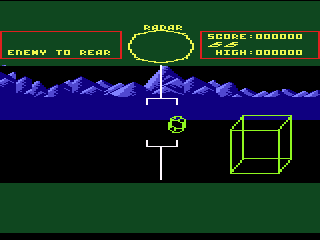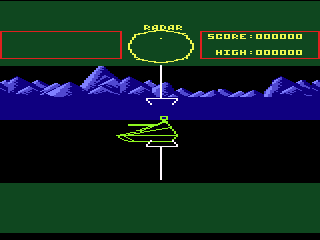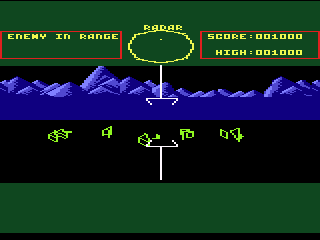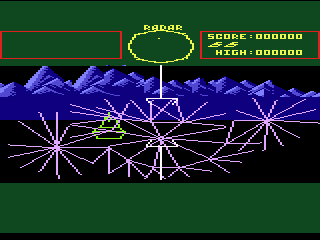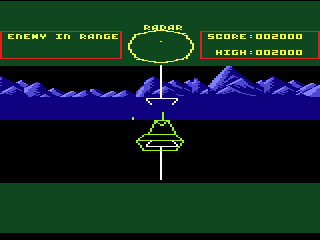|
|
Battlezone
|
Name:
|
Battlezone |
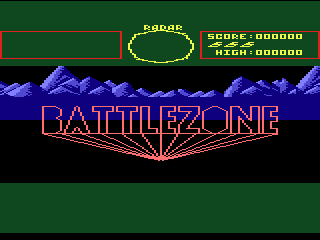 |
| Company: | Atari | |
|
Model #:
|
CX-5239 | |
|
Programmer:
|
Unknown | |
| Year: | 1983 | |
|
Released?
|
No
|
|
|
Notes:
|
Scheduled to be released November 1983 |
Port of the Atari coin-op, Battlezone was an instant hit upon
its release in the arcades in 1980. Not only was
Battlezone one of the first successful vector graphic games, but
also one of the first true 3-D games. When Atari decided
to port Battlezone to its home consoles they went two different
routes based on the capabilities of the hardware. For the
2600 they decided to make everything as standard raster
graphics, but for the 5200 they tried going with mostly vector
graphics. Was this the correct decision? Read on to
find out.
One of the first things you'll undoubtedly notice is that the cool vector mountain range in the background has been replaced with some solid blue mountains. This was probably due to the limitations of the 5200 hardware, as the 5200 didn't possess the Math Box the arcade game did which allowed for all those high speed calculations (although they did use the same CPU otherwise). In the end this isn't a big loss and the solid mountains work just fine, but the famous erupting volcano is missing. Unfortunately one of the issues with the 5200 not having a powerful co-processor for doing all that vector math is that instead of the objects on the screen slowly scaling (growing larger or smaller) to simulate movement, they seem to just jump from one size to the next. This tends to give the game a very choppy feeling, but is still impressive for the hardware.
If there's one area where the 5200 port of Battlezone falls down it's the collision detection. For some reason your shots don't seem to hit the enemy tank as often as they should. This could be due to a error in the collision detection code or be caused by the afore mentioned scaling problem. There have been times when the player is nose to nose with a enemy tank and had the shots go right through it and drift off to the left or right. And while you may have a devil of a time hitting the enemy, they don't seem to have any problem hitting you. Assuming your shot actually hits the enemy, you're treated to nice explosion of parts, which is a surprising since most home versions tend to leave out little bits of eye candy like this. Although tanks can consistently be destroyed with some practice, the flying saucer is very difficult to hit in this version. And while the flying saucer was rare to see in the arcade, it seems to appear much more often in this version. If you actually manage to score a hit on it, it will simply fade away with a weird 'bong' sound.
Collision detection problems aside, the sounds and graphics are top notch. The sounds appear to be all there (including a neat little sound when you run into an obstacle), although seem to be a little sparse but that's how they were in the arcade game as well. The graphics are nice vectors, which other than the scaling problems, seem to mirror the arcade fairly well. One thing that you'll notice though is that you can see some glitches in the vector shapes on the screen when you force them to scale at a rapid rate. This is probably a result of the 5200 pushing too many vectors at once. One minor gripe is that when you get shot your screen doesn't crack down the middle like it does in the arcade, instead you're treated to a weird little star burst pattern that has a line connecting them. While it's interesting to see the computer draw them (it draws one star burst, sends out a line then draws another, sends out a line, etc.) it's nothing like the arcade. There's really no reason for this to have been changed. Perhaps the programmer thought it was more interesting than a simple crack?
One interesting option that the 5200 version of Battlezone offers is the ability of using two joysticks to simulate the 'tank controls' from the arcade version. Although it can be difficult to get used it, using dual joysticks really improves the feel of the game dramatically. It was long assumed that Battlezone would have been packaged in an oversized box with a joystick coupler in the same way Space Dungeon and Robotron: 2084 were, but a picture of the prototype box seen in the movie Cloak & Dagger has shown that it was actually a regular sized box. Of course this box was most likely just a prop and not a real retail box.
Overall Battlezone shows promise but it still needs some minor gameplay tweaking. It's unknown if the only known version of Battlezone to surface was considered by Atari to be complete or not. However since Battlezone was scheduled for a November release and this version is dated late September, Atari probably considered it done. It's unknown why Battlezone was ultimately scrapped, but one theory is that it was sent back for some polishing (missing the November deadline) and then dropped from the schedule due to the video game crash. Interestingly, when Atari decided to release Battlezone for the Atari XE in 1987 they decided to commission a completely new version of the game rather than release the 5200 version.
Possible Prototype Box Artwork
| Version | Cart Text | Description |
| 9/15/83 | Battlezone Cartridge
9-15-83 |
Complete? |

